
Andy Lloyd's Dark Star Blog

Blog 67 (October 2018)
The Goblin Points Out Planet X
The announcement of the discovery a new object in the outer solar system may bring us a step closer to the elusive Planet X (more recently dubbed Planet Nine). This new dwarf object, known as 2015 TG387, is a distant member of the mysterious scattered disk of objects beyond the Kuiper Belt.
Perihelion versus eccentricity of small outer solar system objects (2)
This particular object can travel so far away from the Sun during its orbit that it moves through the inner Oort cloud of comets, beyond 2000AU:
"
The newly discovered object is called 2015 TG387, is probably a small dwarf planet at just 300km across, and is incredibly far away. It is currently lying about two and a half times further away from the Sun than Pluto is. It often reaches much further away. Its orbit takes it to about 2,300 AU — that is 2,300 times as far away from the sun as we are, and vastly more than the already huge 34 AU that the distant Pluto sits at." (1)The object's vast orbit is so vast that it takes about 40,000 years to do one circuit around the Sun. Yet, its orbit is highly eccentric. It distance from the Sun varies from 64AU at perihelion to 2037AU at aphelion. Incredibly, then, it skirts both the Kuiper Belt and the inner Oort cloud, transiting between these quite distinct belts of objects. As more objects are discovered between the Kuiper Belt and the inner Oort cloud (a torus-shaped disk of comets), the classifications of these objects are becoming more complex. A significant factor is whether these objects have perihelia within 40AU, which might briefly bring them within the influential scope of the planet Neptune. Extreme scattered disk objects fall into this category. Significantly, 2015 TG
387 is fully detached from this influence at perihelion, and may be considered to be an inner Oort cloud object.
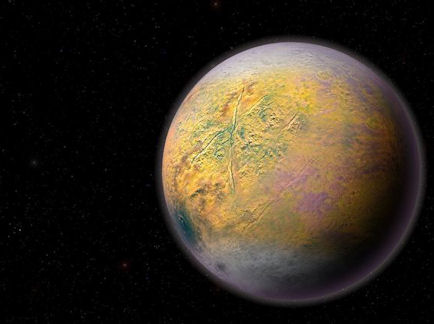
Image credit: Roberto Molar Candanosa and Scott Sheppard, Carnegie Institution for Science
Importantly, its properties fit with the Planet Nine clustering of scattered disk objects:
"2015 TG387 continues the longitude clustering trend seen for the inner Oort cloud objects and ETNOs, which might be caused by a massive planet shepherding these objects." (2)
“If you look at Sedna, and you look at VP113, and you look at a few of the other extreme objects with these very distant orbits, they all are very similar,” [Scott] Sheppard [of the Carnegie Institution’s for Science] says. “They all are clustered on the same part of the sky, they all come to perihelion—their closest approach to the sun—at the same place, and you would expect that to be random across the sky. … That’s why we think there’s a bigger planet out there, because it’s shepherding these objects into these types of orbits.” (3)
In fact, it seems to fit amazingly well in computer simulations involving Planet Nine (as inferred from the clustering of ETNOs). Indeed, without the shepherding presence of a significant Planet X object, it seems incapable of maintaining long-term orbital stability:
"Amazingly, in most simulations with a Planet X, we found 2015 TG387 librates in its longitude or perihelion, keeping it anti-aligned and thus stable with the eccentric Planet X for the age of the solar system. This longitude of perihelion libration is not seen in the the simulations without a Planet X. This supports the theory that a Planet X exists as 2015 TG387’s orbit was only determined after the basics of the Planet X orbit was realized, yet 2015 TG387 reacts with the planet very similarly to the other known IOCs [Inner Oort Cloud objects] and ETNOs [Extreme Trans-Neptunian Objects]." (2)
Finally, in an almost throw-away line which will most certainly set Sitchinite pulses racing, this:
"In addition, some 2015 TG387 clones obtain retrograde orbits yet still remain stable and anti-aligned with planet X for the age of the solar system, suggesting retrograde ETNOs should exist in most planet X scenarios. We further found that the planet itself might be on a retrograde orbit as 2015 TG387 and other ETNOs were similarly stable as in the prograde planet case." (2)
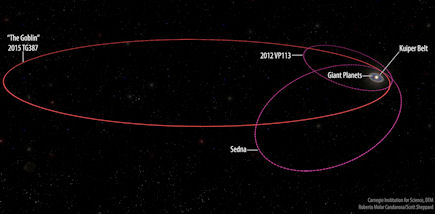
Image credit: Roberto Molar Candanosa and Scott Sheppard, Carnegie Institution for Science
2015 TG387 has been unofficially given the name 'the Goblin' by its discoverers (3). As its name implies, it was originally discovered in 2015. However, because its is so far away, it has taken three years to pin down its orbital path sufficiently accurately to determine its bizarre orbital properties. It seems that other discoveries of distant outer solar system objects, made in the last few years, are similarly being scrutinised (3). In the near future, these may offer further tantalising evidence of the elusive Planet X.
Written by Andy Lloyd,
10th October 2018
References
:1)
Andrew Griffin “Scientists find mysterious object hovering at the edge of our solar system” 2 October 2018, with thanks to Lee2) Sheppard, S., Trujillo, C., Tholen, D. and Kaib, N. "A New High Perihelion Inner Oort Cloud Object: 2015 TG387", The Astronomical Journal, September 28, 2018
3) Jay Bennett “New Discovery Stirs Up Signs of the Elusive Planet 9” 2 October 2018, with thanks to Lee
How Dust Clumps Together in Space
One of the essential ingredients of planet-building is the clumping of dust in space. Planets can build up through the gravitational attraction of objects in space which are already about 1000km across. The problem is how do these proto-planetessimals get built? The mechanism for how dust clumps together has not been well understood. After all, when materials moving at speed through space collide, they may break apart in the force of the impact, showering down collisional cascades of ever small materials - the exact opposite of planetessimal-building. Somehow, dust must clump together into grains, which then join forces to create space pebbles, then boulders, then mountains, etc.
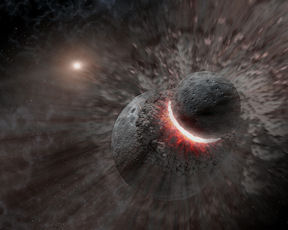
For these materials to adhere together, an inherent stickiness may be needed, aided by the presence of greasy organic compounds (in the form of aliphatic carbon). While it is recognised that this greasy component is more readily available in interstellar space than previously suspected (1), does that adhesive property extend down to space dust? If not, what mechanism could be bringing together ever larger clumps of plain old granular dust in space?
New research work suggests that dust and gas are not happy bedfellows within a magnetic field. So, rather like oil in water, dust particles seem to come together within gas as the mixture traverses the galactic tides. Indeed, any force brought to bear on dust moving through gas seems to create this clumping effect:
"... it was previously assumed that dust was stable in gas, meaning the dust grains would ride along with gas without much happening, or they would settle out of the gas if the particles were big enough, as is the case with soot from a fire. "...dust and gas trying to move with one another is unstable and causes dust grains to come together," says [Phil] Hopkins [Professor of theoretical astrophysics at Caltech]...These gas-dust instabilities are at play anywhere in the universe that a force pushes dust through gas, whether the forces are stellar winds, gravity, magnetism, or an electrical field." The team's simulations show material swirling together, with clumps of dust growing bigger and bigger." (2)
Computer simulations looking at how dust moves through magnetized gas seems to show this clumping effect as a general mechanism. The dust grains are like boulders in a fast moving and turbulent river (the gas within a moving stream of magnetized material). As the flows wrap around these grains and pull them back and forth, the grains have a tendency to coalesce, forming ever larger clumps. This is not just applicable to planet formation in proto-planetary disks, but may also extend to interstellar space:
"As examples, we introduce several new instabilities, which could see application across a variety of physical systems from atmospheres to protoplanetary disks, the interstellar medium, and galactic outflows." (3)
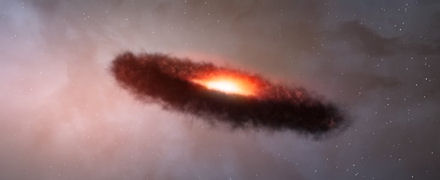
Well, well. Regular readers of the Dark Star blog will recognise that this is a theme that I have been exploring for a few years, in an effort to explain how planets might form in interstellar space. I have wondered for some time how a substantial Planet X body might have formed beyond the extent of the Sun's early proto-planetary disk. I realised that there must be a missing mechanism for planetary formation - that it needn't just be taking place in proto-planetary disks (which it clearly is), but that a slower mechanism for planet-building might also be taking place outside these zones. This was not self-evident, because the Sun clears out the zone around it of dust and gas through the action of the solar wind. The solar wind impedes slow planet-building mechanisms within the planetary zone. Because the planetary zone is what we can observe, we are none-the-wiser as to what's going on beyond it.
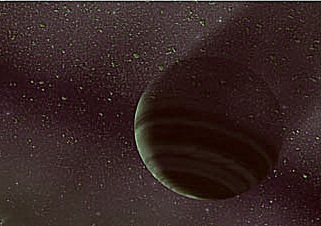
Beyond the heliopause, the mechanism for dust extraction is not taking place in the same way. In interstellar space, particularly within large gas clouds, there should be scope for gradual planet-building. That could extend, intermittently, to the outer solar system, particularly when the solar system moves through gigantic molecular clouds, nebulae, and the like. I wrote this up in a paper in 2016 (4), and have included broad discussions about it in my new book 'Darker Stars', which will be published soon. In 2016, I submitted my paper for publication in MNRAS, but it was rejected on the grounds that it lacked scientific rigour (fair enough - I don't have super-computers at my disposal, after all) and wasn't adding anything new (this reason really puzzled me - I have not come across the concept of planets forming in interstellar space anywhere else in the literature).
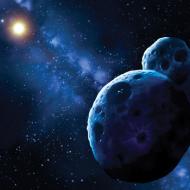
Now, thanks to Professor Hopkins et al., we have some science around this clumping mechanism which could significantly reinforce my arguments. Happily, this new work moves this argument forward significantly. I would suggest that there are significant implications leading on from this. I'll set them out briefly (much more detail in my forthcoming book 'Darker Stars' (5)):
Planet X-type bodies can grow slowly over time because, beyond the heliopause, they reside in interstellar space where dust may clump, free of the action of the solar wind.
Because this is a general principle, any older star system may have one or more wide-orbit planets beyond its heliopause, perhaps a number of them.
This mechanism could lead to the formation of an abundant supply of dark, free-floating planets in interstellar space. These need not have been ejected from young planetary systems, but could be native denizens of interstellar space.
Continued dust clumping in the vicinity of substantial Planet X bodies will be aided by the juxtaposition of moving interstellar medium and their powerful planetary magnetic fields.
This will lead to the accumulation of shrouds of dust around substantial Planet X bodies (6). The same would apply to free-floating planets.
These localised shroud-like nebulae will impede efforts to observe the planets in infrared. They will also lead to misidentification of these phenomena during surveys in visible light (7)
This would then explain why the presence of a Planet X object can be strongly inferred from indirect evidence, yet continue to evade direct detection.
This argument seems logical and coherent to me. It seems that science is now providing the mechanisms whereby it could be substantiated. It also seems something of a coincidence that this work is emerging from Caltech, now so famous for the Planet Nine hypothesis (8). Is it part of a similar push to understand how Planet Nine could be? I would argue that this helps beyond providing the mechanism for its formation (as important as that is). It will also explain why we can't seem to find it.
Written by Andy Lloyd, 1
2th October 2018
References:
1)
Andy Lloyd "Space Grease and Interstellar Objects" 30 June 2018,andylloyd.org/darkstarblog63.htm
2) Whitney Clavin "How the seeds of planets take shape" 10 October 2018, with thanks to John
3) J. Squire et al. "Resonant Drag Instability of Grains Streaming in Fluids", The Astrophysical Journal, 23 March 2018, 856:1
4) Andy Lloyd "The Cumulative Effect of Intermittent Interstellar Medium Inundation Upon Objects In The Outer Solar System" 02/2016, DOI: 10.13140/RG.2.1.5112.5526,
5) Andy Lloyd "Darker Stars" Timeless Voyager Press, 2019
6) Andy Lloyd "The Shroud Hypothesis " 12 January 2015,
andylloyd.org/darkstarblog22.htm
7) Andy Lloyd "The Shroud Hypothesis as part of a Dark Star Solution" 9th February 2016,
andylloyd.org/darkstarblog35.htm
8) K. Batygin & M. Brown “Evidence for a Distant Giant Planet in the Solar System” 20 January 2016, The Astronomical Journal, 151(2)
Roaming Centaurs Posed Threat to Earth, too
The cut-and-dried nature of the defined categories of solar system objects seems to be constantly under fire. When are comets really asteroids? Were water-bearing asteroids, capable of crossing Earth's orbit during the early solar system, the bringers of Earth's water? Such questions are rendered more complicated still by theories of solar system formation, within which sit complex patterns of planetary migration. It's becoming ever more difficult to determine where any particular object originated from. The complex evolution of the solar system shifts the ground between the feet of astrophysicists charged with trying to understand this melange. They can reasonably easily categorise objects into collections of objects. For instance, giant planets have 'followers' in stable pockets set along their orbit, which are known as Trojans. There are other collections of objects past the known planets, including those within, and beyond, the Kuiper Belt. Then there are the Centaurs.
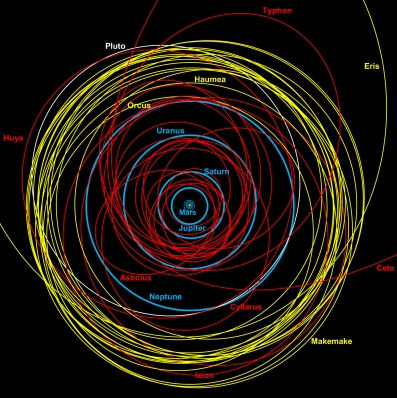
Centaurs are minor bodies in the solar system which orbit the Sun among the giant planets - in other words, between Jupiter and Neptune. They seem to have emerged from the Kuiper belt originally, and their current paths are an expression of a gradual orbital evolution. Although the Centaurs generally stay within this outer planetary zone, new research emerging from the University of Vienna (in collaboration with Brown University) indicates that just over 50% have been capable of moving within Jupiter's orbit during the 'modern era'. Some of these, amounting to 7% of the total known population of Centaurs, have been capable of interacting with the inner terrestrial planets, extending as far into the inner terrestrial zone as Venus (1).
The implication of this is that Centaurs may have impacted our world in the past, just like asteroids and comets. As a result, the water on Earth may, at least partly, have been delivered here by Centaurs, which themselves originated from the belt beyond Neptune. This seems to be the equivalent of the amount of water in the Adriatic sea (2). Other terrestrial planets, like Mars and Venus, may have also received deposits of Centaur water in the past. The main period during which these bombardments took pace occurred during the 'late, heavy bombardment', which began about 4 billion years ago. The solar system eventually settled down after quite an extended period of impact activity (perhaps half a billion years long). The evolution of the orbits of the Centaurs calculated by the astrophysicists goes back to this tumultuous period, and presents the likely role played by the Centaurs in cratering the terrestrial planets since then.
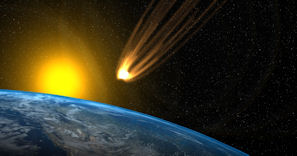
Working from the known Centaurs population - assumed to be stable during the "modern era" since the late, heavy bombardment - there have been perhaps two catastrophic events on Earth attributable to a Centaur impact. One might have been the Extinction-Level Event that is thought to have wiped out the dinosaurs, although this particular event could also have been due to the incursion of an asteroid or a comet. Until this work, Centaurs had not been considered a threat to the Earth.
Written by Andy Lloyd, 1
2th October 2018References
:1)
M. Galiazzo, E. Silber and R. Dvorak "The threat of Centaurs for terrestrial planets and their orbital evolution as impactors", Monthly Notices of the Royal Astronomical Society, 482(1): pp771–784, 24 September 20182) University of Vienna Press Release "The threat of Centaurs for the Earth" 5 October 2018
Life-bearing Moons in Interstellar Space
Dark planets moving independently through interstellar space are known to exist - a patchy picture has been built up gradually from the discoveries of rogue young brown dwarfs, microlensing events and infrared sky surveys . How many are out there is much less certain, with estimates hanging around the same number as that of visible stars: Sometimes more; sometimes considerably less. The truth is, no one really knows. The assumption is made that all of these sub-stellar worlds originated from star systems, and were ejected during the chaotic early stages of planetary formation, and subsequent periods of planetary migration. As noted above, I think that there is also a case for these objects to form, and build in interstellar space, but that is not generally accepted thinking, by any stretch of the imagination.
Image credit: Dan Durda/AP
Recent computer simulations by astrophysicists have sought to determine whether ejected gas giant worlds might manage to hold on to their moons. It turns out that a significant proportion of these moons do indeed ride out of town with their parent planets; perhaps three quarters of them (1). There are implications for life here. As I have been writing about for about 20 years now, moons orbiting gas giants are internally warmed by the proximity to a massive gravitational force. This process of tidal warming can maintain internal conditions suitable for life (like sub-surface oceans). If you step up the parent's size to a sub-brown dwarf, then this warming effect is compounded by the moon's proximity to a relatively warm object capable of producing flaring, aurorae and a massive magnetic field.
We often think of moons as being rather like our own - desiccated, barren, lifeless. But there need not be a limit to the size of the moon, or a strict set of properties applied to it. There is nothing to stop a gas giant binary, for instance, or an ice giant orbiting a gas giant. Such a system has been discovered recently using the Hubble Space Telescope (2), although its cautious announcement by the astronomers from Columbia University comes with caveats (3). The host planet, Kepler-1625b, orbits the star Kepler-1625. The light from the planet is dim, and essentially is mixed in with that of the star's.
Often planets are discovered as they transit across the face of a star, dimming it. So, if you want to find a moon, you would look for a much fainter secondary dipping of light from the star/planet combination. This tiny dip might well be attributable to a substantial moon - the size of Neptune or Uranus - crossing the face of the star during that main planetary transit, causing a further fluctuation in light. To be sure, such a fluctuation would need to be observed on more than one occasion, and the proposed existence of a moon around Kepler-1625b need confirmation from further careful observations of the system.
"According to the researchers, another compelling piece of evidence in favor of a moon is that the planet passed in front of its star more than an hour earlier than predicted. A moon could cause that kind of an uncertain, wobbly path, they noted." (3)
This planet and moon orbit a star. Nonetheless, there's nothing stopping substantial binary planets like this from being ejected together into interstellar space. They would effectively become dark planetary systems. If the main object is a sub-stellar object like a sub-brown dwarf, then the potential for life within such a system moving through interstellar space is surely good, if not excellent.
Written by Andy Lloyd, 1
4th October 2018References:
1)
Belinda Smith "Moons around 'rogue planets' could sustain life — no solar system required" 10 October 2018, with thanks to Mark2) Alex Teachey and David M. Kipping "Evidence for a large exomoon orbiting Kepler-1625b" Science Advances, 4(10): eaav1784, 3 October 2018
3) Associated Press "First Moon Outside Our Solar System May Have Been Found and It's Massive" 4 October 2018,

You can keep informed of updates by following me on Twitter:
![]()
Or like my Facebook Page: https://www.facebook.com/darkstarandylloyd